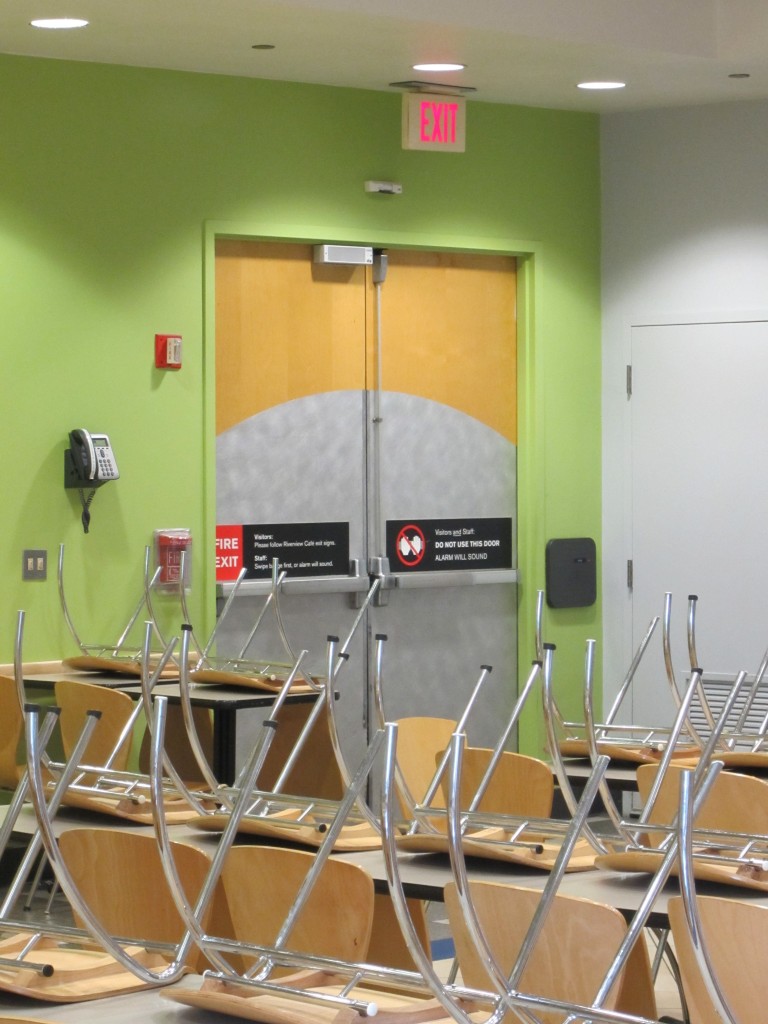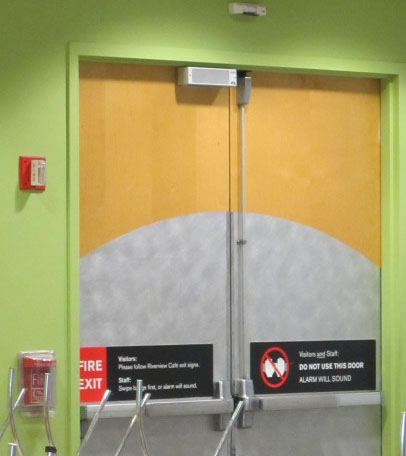 Remember this door from my trip to the science museum last week? I asked what was wrong with it and several of you had good ideas.
Remember this door from my trip to the science museum last week? I asked what was wrong with it and several of you had good ideas.
This area of the cafeteria was closed and the doors were secure, so there are some things we don’t know. We don’t know for sure if the doors are fire-rated, although I didn’t see evidence of mechanical dogging. If they are fire doors:
- The armor plates are a problem unless they are labeled, because they are more than 16″ above the bottom of the door.
- The vertical rod device is missing the bottom rod and latch, so the doors would need an auxiliary fire pin installed on the edge. This pin projects into the other door edge if there is a fire, and holds the doors in alignment. We don’t know if there is a pin installed because it wouldn’t be visible in this view. Plus, this application is only approved when there are two vertical rod devices.
- The other door has no visible rods, so it could be a) a mortise exit device, b) a surface vertical rod device whose rods have been removed, c) a concealed vertical rod device, or d) a rim device with a surface-mounted strike. If it’s “d”, the doors would need a coordinator to function properly, and the surface-mounted strike is not allowed on a fire-rated opening. It’s highly unlikely that it is “c”, because it would be unusual to have two different types of vertical rod devices on the same door. It’s possible that it’s “b”, and if the rods and latches have been removed, that’s obviously a problem for a fire door (I don’t see any old screw holes). If it’s “a”, then a coordinator is required and there isn’t one installed. For what it’s worth, I think it’s “d”.
What I noticed had nothing to do with a possible fire rating. The operational description of this door is that staff members present an ID badge to the reader on the right side of the doors, and then walk through the door leaf on the left. That door is equipped with a delayed egress mag-lock. If someone pushes on the door without presenting their badge, an alarm will sound, and after 15 seconds the door will unlock to allow egress. Upon fire alarm, the delayed egress lock unlocks immediately (no 15-second delay). I see a motion sensor above the door but I’m guessing it is related to the detection system and not part of the access control system.
The first issue with this delayed egress application are that delayed egress locks are not allowed on doors serving Assembly occupancies per the International Building Code, which our Massachusetts code is based on. For any of you who are NFPA 101 users, the Life Safety Code does allow the use of delayed egress locks on doors serving Assembly occupancies, as long as it is not the main entrance. The other code problem is that the doors lack the proper signage for delayed egress locks. The sign needs to read “Push until alarm sounds. Door can be opened in 15 seconds.” These doors have signage, but it does not include the proper language.
And in the category of “Things that Make You Go Hmmm,” what’s to prevent someone from pushing on the door without the delayed egress lock? What’s the point of having delayed egress on one door, and free egress or maybe just an alarm, on the other? Any theories??
You need to login or register to bookmark/favorite this content.






Lori,
If the left leaf has either a mortise device or a rim device (with surface mounted strike on the right device, wouldn’t attempting to open the right leaf also set off the delayed egress (assuming they have the door motion triggering it)? Essentially, if the left leaf is magnetically locked, the right leaf would get stuck and would not have free egress.
Yes, Joe! I think you’re right!!
I am thinking no
The right side door will open freely by the panic hardware and may or may-not sound an alarm
The left side when you hit the panic bar will electrically release the mag lock, and maybe without delay!!!
On the left door below the panic bar on the left side is there a box there or is that a shadow
Joe (see previous comment) pointed out that if the door on the left has either hardware option “a” or “d”, then attempting to open the door on the right will move the door on the left, which is what begins the delayed egress process (alarm and release after 15 seconds). If the door on the right operated independently, then it would have no effect on the delayed egress lock and there would be no point in having delayed egress.
I don’t think there’s a box on the door.
I give up what is a&d ????
The delayed I have seen has to have the panic bar depressed to start the sequence, not just pushing on the door itself
How do you know the left door is “delayed egress” and not just if you push on the bar the mag releases ?????
When I said “a” or “d” I was referring to 2 choices I mentioned in the blog post – two different types of panic hardware that might be on the door on the left. Either of those two types would be latched into the door on the right, so moving the door on the right would also move the door on the left. The mag-lock is a delayed egress mag-lock – I could go into detail about how I know that but your eyes would glaze over. With this lock, moving the door is what starts the timer. It doesn’t interact with the panic device, although there are some mag-locks that do.
Interesting have not seen where a lock is activated by just movement of the door
Here’s some product info on this type of lock: http://w3.securitytechnologies.com/products/system_components/electromagnetic_locks/Pages/details.aspx?InfoID=4
Click on M490DE Delayed.
Well that is an interesting device, have not seen that used before
Seems like the business only wants employees to use these doors
After looking at this picture for a few minutes, I have a guess as to what is going on, based on the available evidence.
I think the most telling part of the picture is the REX motion detector above the door. That leads me to believe that this door started it’s life as a free egress door.
There is likely a card reader on the other side, restricting access into the cafeteria. The vertical rod door acts as a fixed leaf and likely has no trim on the outside. The other door was the controlled door. I would have specified an electrified exit device or electrified trim, with a built in REX on the bar. However, since I see the REX PIR motion detector, I’m guessing that this was specified to have a magnetic lock on that leaf and have passage trim on the outside. They probably also had an exit button where the reader is now located to the right of the door.
Then, someone decided to control access from the cafeteria out of the door. Since this is required for egress, they didn’t want to completely lock it down (like many places do). They had the right idea, even though they may not have executed it 100% right. In the past, I’ve specified openings like this to have a reader, completely free egress, an alarm sounder and lots of signage saying that the alarm would sound if people didn’t swipe their card first. In this condition, because of the magnetic lock, they would have had to leave the exit button. Human nature is a funny thing. Regardless of how much signage is on a door, when people see an exit button, they push it.
So, with that said, they probably thought that they needed to get rid of the exit button. Since they already had a wiring pathway and a hole, that was the perfect place for a reader. Considering the size of the reader (it looks like an HID MaxiProx, which is a long range reader), I would thank that staff are carrying their lunches on trays to go back to their desks, and they used a long range reader so the staff would be able to operate the door hands free.
Since the exit button is gone, they likely wanted to try to meet egress code and decided to change the regular mag lock to a delayed egress mag lock. At first, I thought it may have been a delayed egress mag lock anyway, because it was on a door with a panic device. Even with the button and motion, I’ve seen some people that have asked for an additional method of release, just to be safe. However, if the door has passage trim,someone outside could have just pulled on the door for 15 seconds and it would have popped open, so I don’t think that’s the case.
In this final condition, they still maintain access control and locking from the outside but it can likely be bypassed by pulling on the door (which would set off the alarm). From the inside, one leaf is free egress and would set off the alarm while the other is delayed egress and would set off the alarm. At first, I thought they left the motion above the door just to cover the old hole and it wasn’t doing anything. After looking again, I don’t see an alarm sounder at the door (I may be missing it or it may be on the other side of the door). Some motions have built in alarm sounders, so they may be ignoring the REX function and just use it as an alarm sounder.
That’s my best guess so far. Could be right… Could be completely wrong…
The postings on this site are my own and do not necessarily represent my employer’s positions, strategies or opinions.